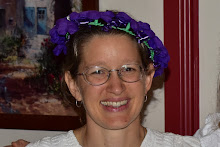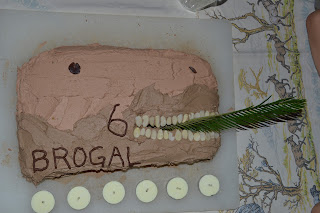Math Club 1/15/16
A week ago I restarted an activity that my children and I
really enjoyed in New York: an enrichment math club. I had planned to hold the
club at a local park, but when I woke up that day it was wet and grey, so I
changed the venue to my house. Given an enthusiastic response when I posted it
on Facebook, I had been concerned that not everyone would fit, but as it turned
out only 2 families were able to come. This was actually a good number to begin
with – three 10-year-olds (including a set of twins) and one younger sibling,
as well as my own children.
My idea for today’s lesson was to approach binary in a way
that would be generally accessible, since I wasn’t sure how many younger
children would be involved, and then to move to a more formal introduction. I was
inspired by James Tanton’s “Exploding Dots” course (http://gdaymath.com/courses/exploding-dots/),
and started with a physical activity based on the 1 <– 2 machine. Here’s how
the activity went.
First, I placed a few sheets of paper on the floor in a line.
I pointed out that a sheet of paper is fairly small; only one person can
comfortably stand on it. So, if you ever have more than one person on a sheet
of paper, the two EXPLODE! Only one “survives” the explosion, and that person is
knocked to the next piece of paper in line. New people can only join the game
by standing on the first sheet of paper in the line. So, after the first person
joins the game, there is one person on the first piece of paper. Add in a
second person, and they EXPLODE, and one of the two is left standing on the
second piece, with the first piece empty. Add a third, and s/he can stand on
the first piece without a problem: a person is on each of the first two places.
Adding a fourth person is fun: the two on the first place EXPLODE, one joins
the person on the second place, they EXPLODE, and one goes and stands on the
third piece. If you’re familiar with binary, you can see where this is going;
if not, try it out yourself (or click through to the Exploding Dots link). Some
of the participants wanted to keep one person in the first place and explode
the second person into the next place. I wish I’d thought of letting them play
with that for a while – it would have been a base 1 system – but I just tried
to re-explain that only one person can stay in the game after the explosion.
After we’d added in 5 or so people, I got out the
whiteboard, and we started over again, writing down what happened if we dumped
on a whole bunch of people at once. Someone suggested trying to put 9 people on
the first sheet of paper, which required all 5 of mine and all 3 ten-year-olds,
plus myself (holding E1), but it didn’t work too well because several people
(all mine) wandered off before being exploded and were hard to find again (and
to keep track of). At this point we moved to using the whiteboard exclusively.
I drew 4 boxes, and we began making a chart, using what the
children didn’t yet recognize as standard binary notation: 1 is 1, 2 is 10 (a
person in the second place as a result of the 2 who exploded in the first
place), 3 is 11 (a person in each of the first 2 places), 4 is 100 (only one
person left on the 3rd place, with the first 2 empty). I had them
take turns drawing each subsequent number of dots in the first place, carrying out
explosions and writing the resulting binary number in a somewhat organized chart.
We went up to eleven or so (1011 in binary).
At that point, I got out the main manipulative I had
prepared, a set of 5 cards containing 1, 2, 4, 8, and 16 dots respectively. I
let them look at the cards and say what they noticed. “They’re all even!”
“Except 1 isn’t.” “And 6 is missing.” “And 10.” Finally, “Oh, you have to
double them.” Once that idea was mentioned, everyone agreed: it was a sequence
of numbers you get by repeated doubling. Once they’d realized that, I asked
them to make numbers using the available cards: 7 (1+2+4), 13 (1+4+8), 21
(1+4+16). Is there only one way of making each of these numbers, or could you
find another way to do it? Well, all 4 children who were still engaged with the
activity did it the same way, and no one could think of another way. “Unless we
got into teams and had 2 of each card.” But with just one set of cards, we
agreed that there was only one way to make each number.
The next step was to ask if there was any connection between
the activity with the cards and the activity with the exploding dots. This
puzzled them for a little while, so I set up a set of dot cards in order beneath
one of the binary numbers we’d written on the board, with each card marking a
place. They were able to see that, for example, 1010 was the same as 8 + 0 + 2
+ 0.
Someone noticed that five in binary is 101, and ten is 1010.
“What’s twenty?” They found it was 10100, which was an interesting pattern. I
asked if anyone had any guesses about what forty might be, and there was
general agreement that it should be 101000. We had to add another place,
though, since our dot cards only went up to 16, but when we’d added the 32
place we noticed that 40 was indeed 32 + 8. I had thoughts at this point about
doing some addition (with carrying) and subtraction (with borrowing), but I
could tell that people had about reached the end of their interest with the
activity, so we wound up and everyone left.
Things that went well: Letting them say what they noticed
about the base 2 cards, noticing patterns of doubling and halving (5, 10, 20,
40 translates to 101, 1010, 10100, 101000), letting them hold the whiteboard
markers, asking children to explain their reasoning whether the answer was right or wrong (which helped me see how my explanations were going awry).
Things that didn’t go as well: Whiteboard markers running
out of ink (repeatedly), allowing some people to dominate the conversation and
failing to include others, not explaining the rules of the game carefully
enough for everyone to understand that one of the people in the explosion
disappears completely, drawing 4 boxes on the whiteboard before we needed all
of them (should have added boxes only as needed).
Plan for next time: I have no idea which of the same children
and which new ones – of which ages – will come, but, weather permitting, I’m
hoping to do it at the park. We’ll look at fractals – there’s a gorgeous,
enormous tree there, so tree fractals will flow naturally. I’ll try giving each
child a sheet protector with cardstock inside it, and a (new) whiteboard
marker, so they can each explore without one child dominating. I’m particularly
enamored with Sierpinski’s triangle and the Koch snowflake, so those will
certainly feature. I’ll plan to post again with how it goes.






